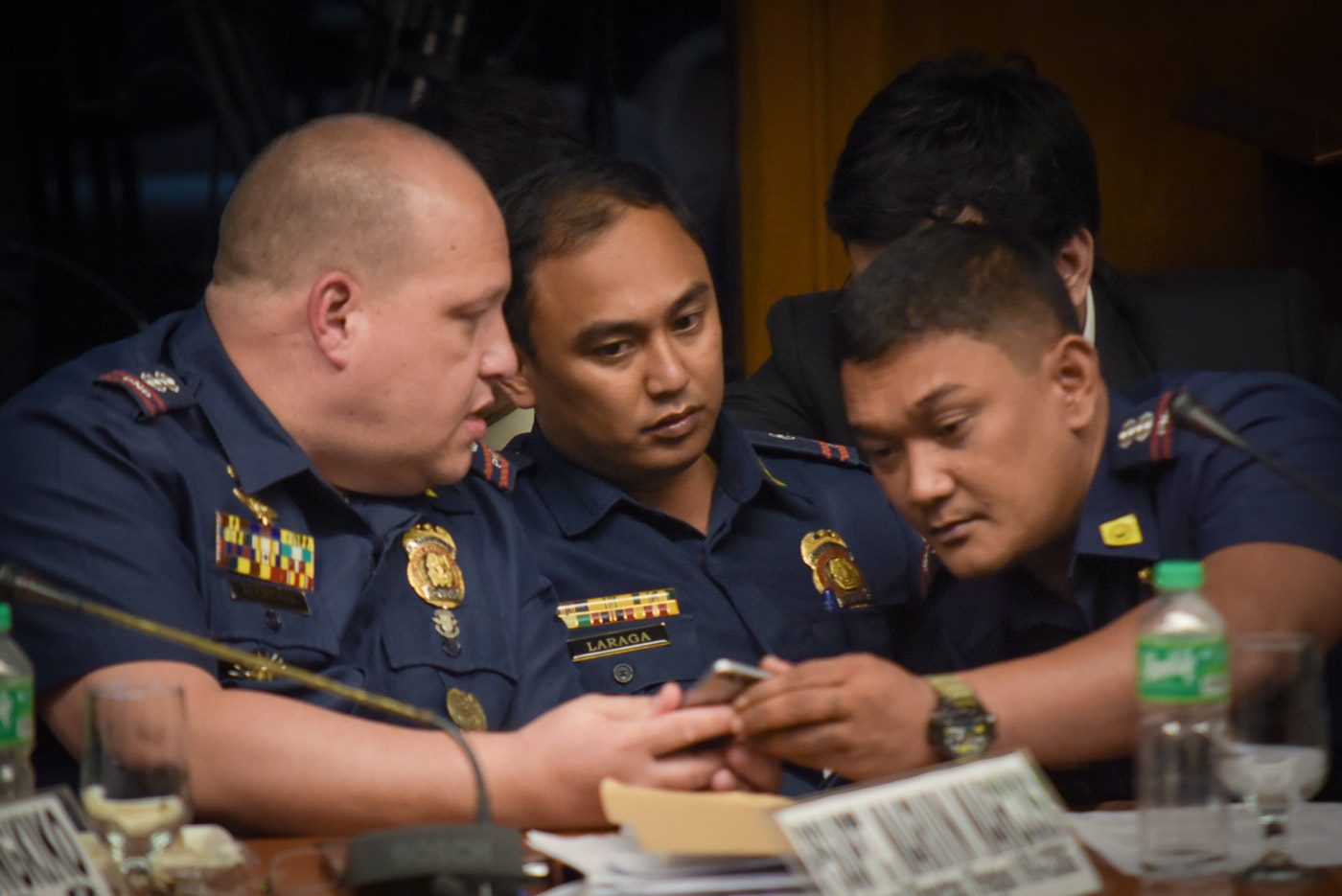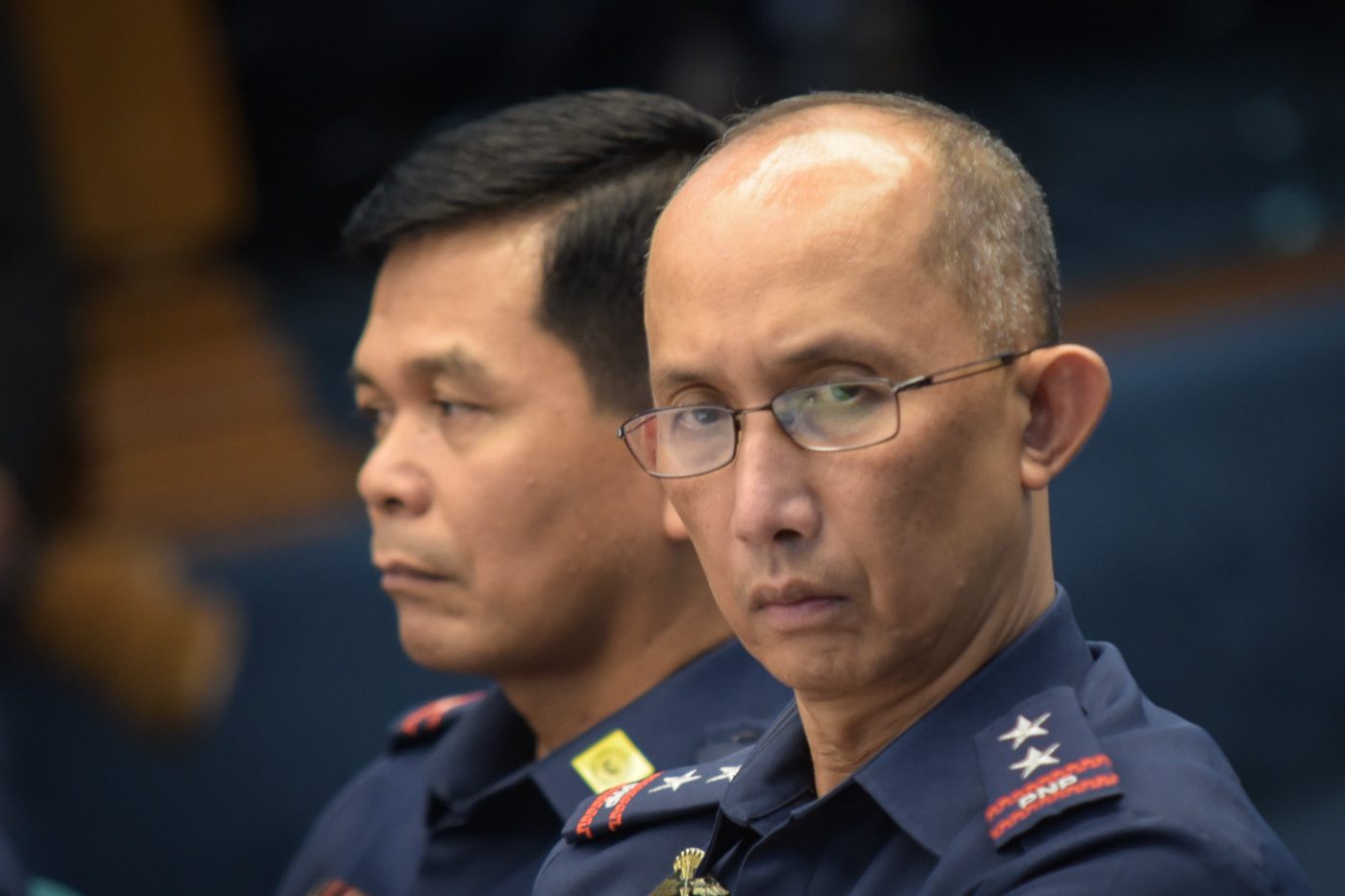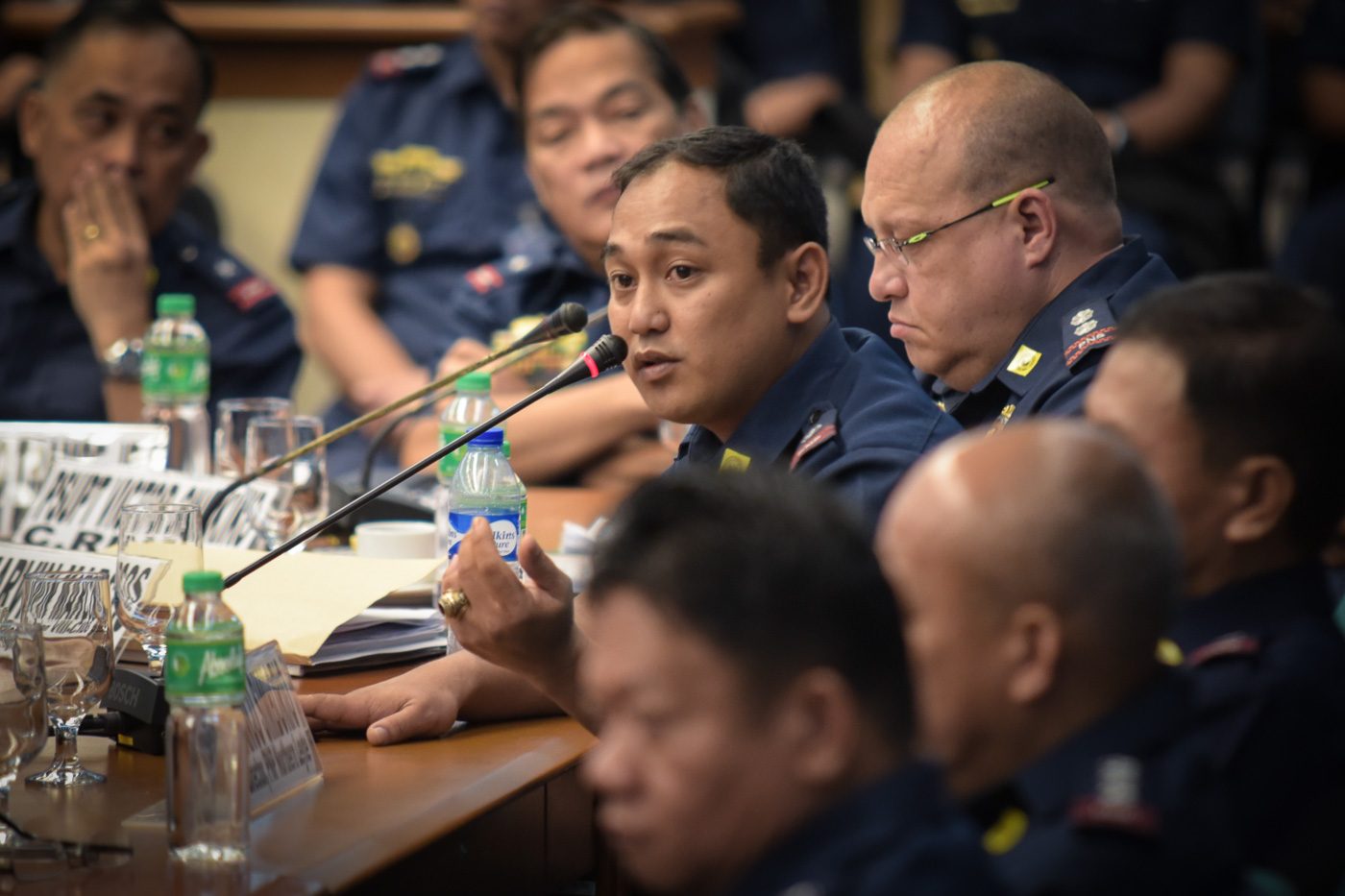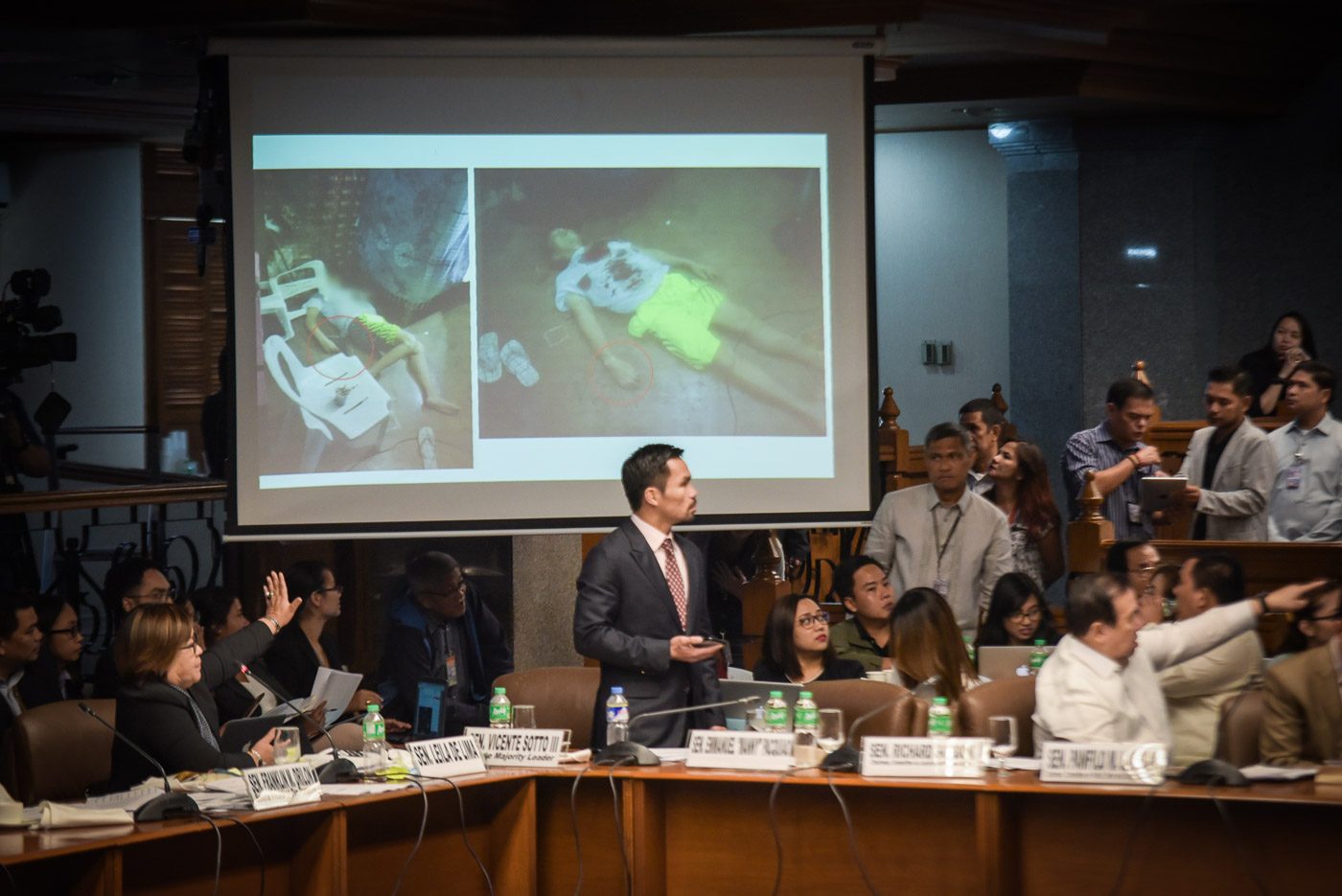SUMMARY
This is AI generated summarization, which may have errors. For context, always refer to the full article.

MANILA, Philippines – During the first hearing of a congressional inquiry that lasted over 8 hours, senators who grilled authorities over an operation that led to the death of a mayor linked to illegal drugs made the same general conclusion: it was a case of extrajudicial killing by the police.
On Thursday, November 10, the Senate probed into the death of Albuera Mayor Rolando Espinosa Sr during a supposed police operation inside the Leyte sub-provincial jail in Baybay City, Leyte. (READ: Espinosa death: 3 issues police need to answer)
Espinosa, the first local chief executive to “surrender” to authorities over his alleged involvement in illegal drugs, was killed on November 5 after he supposedly fired at police trying to serve a search warrant for firearms inside his prison cell. Another casualty, inmate Raul Yap, also supposedly fought back.
The deaths of the two come as the country enters the 5th month of Duterte’s popular, controversial, and bloody “war on drugs.” Since the get-go, police have been accused of resorting to summary killings in pursuit of the campaign.
“First, the procedures they followed were wrong. Second, it seems as though their intention was not to capture but to kill,” Senator Richard Gordon, chair of the committee on justice and human rights, would tell media on the sidelines of the hearing.
At the end of the Senate probe into the spate of deaths linked to the government’s war on drugs weeks earlier, Gordon had said that neither Duterte nor the state ordered the killings.
Senator Manny Pacquiao, fresh from a victorious boxing match in Las Vegas, cracked jokes and made quips about his spiking blood pressure as he interrogated CIDG 8 police. But he was serious in chastising them for the alleged mistakes and holes in their narration of the November 5 operation.
All throughout the hearing, different senators, including – a former PNP chief, Senator Panfilo Lacson – expressed disbelief over the CIDG 8’s version of the story.
The collective indignation at the Senate, however, had no impact on Duterte. Hours after the hearing, he said he believed the police’s version of the story. “I would insist that the version of the police is the correct version. Insofar as I am concerned, I will not abandon them. If they go to prison, so would I,” he said Friday night, November 11.
As the Senate prepares for at least one more hearing to probe Espinosa’s death, Rappler summarizes the key findings senators have made so far.
1) NO COORDINATION
One glaring misstep in the operation, according to police officials and senators who themselves were once part of the uniformed service, was the lack of coordination between the operating units (CIDU 8 and Maritime Group 8) and the regional, provincial, and city forces.
“Commanders should always be informed. [CIDG 8] should be under the RD of Region 8, operational control. In the same manner that he has a CIDG director,” explained Director Benjamin Magalong, PNP Director for Operations and former CIDG chief.

Former CIDG 8 chief Superintendent Marvin Marcos and team leader Chief Inspector Leo Laraga, according to Magalong, should have informed not just the Baybay City police, but their regional director, Chief Superintendent Elmer Beltejar, and Senior Superintendent Franco Simborio, Norther Leyte provincial director.
Marcos cited the sensitivity of the intelligence they gathered – from a “walk-in informant” – as his reason for not informing other police units. Magalong explained that while CIDG units may operate and make their own calls, when the target is as high-profile as Espinosa, coordination with higher-ups is necessary.
The two junior officers from CIDG 8 informed their superior, CIDG director Chief Superintendent Roel Obusan, only when the operation was underway. The Baybay City police were likewise left in the dark until the operation started.
Magalong was no stranger to the importance of coordination, especially in high-stakes operations. In 2015, Magalong headed the investigation into the bloody “Oplan Exodus”, which was also the subject of a Senate probe. The PNP’s Special Action Force (SAF) were then found to have failed to properly coordinate with military forces that operated in the area.
The CIDG 8 unit also failed to coordinate with the jail warden, who knew of the operation only when the team arrived. The jail warden was at home in Dagami town, Leyte, when police entered the sub-provincial jail in Baybay City.
“They coordinated by using a bolt cutter. They coordinated by disarming the guards,” Lacson quipped.
Senate Minority Leader Ralph Recto, reading the search warrant, pointed out that while serving a warrant was allowed anytime, day or night, it also required coordination with jail officials.
2) ROLE OF ‘WALK-IN’ INFORMANT
CIDG 8 police had apparently applied for the warrant because of information from a “walk-in” informant whom the unit had not worked with before. The informant supposedly had first-hand information that Espinosa had a firearm inside his cell and that Yap was selling shabu in jail.
The informant went to the CIDG office on October 29. Five days later, on November 4, Laraga went to Basey, Samar, to apply for a search warrant. At 10 am the same day, the judge interviewed their witness – the informant. The judge granted the warrant application 5 hours later.
The CIDG 8 team arrived at their office in Tacloban City by 5:30 pm, and met with Marcos and other officials 30 minutes later. By 12:30 am on November 5, the team conducted a briefing for the service of the warrants.

The narration of the events that led to the operation in the first place raised not a few questions from police officials and senators. Magalong pointed out that police should have taken more time to validate the claims of the informant, especially because they were unfamiliar with the person. Senators said they wanted the CIDG 8 informant to face the Senate committee.
But the application of a search warrant for an operation inside jail, Magalong pointed out, was “not standard practice.” Pacquiao pointed out that it was unusual to apply for a search warrant because Espinosa was already in jail.
Marcos argued that they applied for a search warrant because of their supposed previous experience with uncooperative jail officials. At the same time, however, CIDG 8 police apparently did not show jail guards the said warrant when they entered the facility.
Recto, for his part, pointed out that the warrant explicitly states that the search should be conducted “…in coordination with the chief of the Baybay sub-provincial jail.”
The warrant also covers jail cell numbers 1 and 2, supposedly occupied by Espinosa and Yap, respectively. Based on the testimony of the “walk-in” informant, Espinosa had a .45 caliber pistol inside his cell. The post-operation police report, however, says a .38 caliber gun was seized from Espinosa and a .45 caliber seized from Yap’s cell.
The apparent inconsistencies in the basis for the intel cops’ search warrant application and the final outcome of the operation prompted senators to criticize them for their flawed “script”, implying that the police were lying about the circumstances of the killings.
But the differences in firearms seized wasn’t the biggest blip in the narrative of the police.
3) SOCO CONTACTED BEFORE OPERATION
One of the biggest zingers during the hearing was the revelation that Superintendent Noel Matira, one of the cops who joined the operation, had called up the regional police office in Tacloban City to ask for Scene of the Crime Operatives (SOCO), a full hour before police even entered the jail.
In turns out that Matira even contacted other areas requesting for a SOCO team.
Based on the records of regional police, Matira called up at 3:38 am to request for the SOCO team. The SOCO processes crime scenes, particularly those that involve deaths. Typically, operating units call the SOCO after the operation is done, if they’re sure a suspect or any other person is already dead.
Police did not even enter the jail premises until 4:30 am.
“Para kayong tumawag ng punerarya, wala pang engkuwentro (It’s like you called the funeral home even before the encounter happened), quipped Lacson.

But Marcos insisted the times indicated in a timeline he himself submitted to the Senate panel were mere estimates of key moments in the operation. Matira said he forgot what time he placed the calls.
Based on Marcos’ own timeline, Matira made the call in between conducting a final briefing at the Baybay bypass road at 3:30 am and the Baybay City police station’s receipt of a “coordination form” as the final briefing was ongoing at 3:43 am.
At 4:05 am, or a full 20 minutes or so after the request for a SOCO team, the Philippine Drug Enforcement Agency (PDEA) received the “pro ops and coordination form” from the CIDG 8 team. All anti-illegal drugs operations by any law enforcement agency must be coordinated with PDEA, the lead agency for narcotics.
Marcos said the apparent discrepancies were mere “technicalities.”
Another “technicality” that does not jive with the CIDG 8’s narration of the operation was the trajectory of the bullets fired into the body of Espinosa. Based on the medico-legal report, the bullets that hit Espinosa were fired from an “upward trajectory.”
Chief Superintendent Benjamin Lara, CIDG medico-legal chief, explained this means that Espinosa was either standing up and at a higher elevation from the shooter or was lying down, with the shooter standing up.
Laraga admitted he himself shot Espinosa but insisted he never entered the jail cell itself because the mayor had already fired shots. There were no indications that Espinosa was shot at close-range, however.
There are several long gaps in the CIDG 8’s timeline of events. According to Marcos, the team led by Laraga was able to enter at 4:30 am. The SOCO team eventually arrived at 5:58 am, and at around 9:40 am, the SOCO team finished processing the cell of Espinosa.
It took another hour-and-a-half before the CIDG team eventually left the jail. “The jail management refused to sign the turnover of premises and certificate of orderly search,” Marcos noted in his presentation.
4) INADEQUATE PROTECTION FOR ESPINOSA?
Senators also lamented the apparent lack of effort in providing Espinosa security after his arrest. Senator Leila de Lima, for instance, wondered why regional and provincial police did not work on placing Espinosa under the witness protection program.
Ironically, De Lima was among the officials charged before the Ombudsman in Tacloban City based on claims made by Espinosa.
Beltejar said they had not yet considered putting Espinosa under the justice department program but they had taken steps to ensure his security. Chief Inspector Jovie Espenido, police chief of Albuera, said the region eventually deployed 4 police personnel to guard Espinosa’s cell at the Baybay jail. CIDG police would instruct these same policemen to kneel facing the wall, their guns on the floor, behind them, when CIDG police entered the Baybay city jail.

The Eastern Visayas regional director later said that there was a pending motion before the courts to move Espinosa from the sub-regional jail to the custody of Albuera police.
Espenido, speaking to media after the hearing, said he wanted to emphasize that they exerted effort to secure Espinosa but such legal processes take time.
Prior to his arrest, Espinosa executed two affidavits before Albuera police. The two documents named at least 50 people who supposedly received “protection money” from Kerwin Espinosa.
But Espenido had earlier said over 250 people – from politicians, police, to members of the judiciary – are named in the “blue” and “pink” books of the Espinosas, or the books where they listed supposed payola payees.
It is this expansive network, Marcos and Laraga reasoned, that explains why they asked for a warrant in Basey and not in Tacloban or Baybay City. Basey is about an hour’s drive from Tacloban City and around 3 hours from Baybay.
Marcos hinted at corruption among the judiciary in Leyte, but later downplayed this when senators began grilling him. Ironically, Marcos himself has alleged links to the Espinosa drug trade, if the mayor’s affidavit is to be believed.
The police superintendent, a Tacoban native, confirmed during the hearing that he is related to Lalaine Jimenea, listed in the late mayor’s affidavit as a media personality who allegedly received money from Kerwin. According to Espenido, Jimenea is also a “publicist” for Ormoc City Mayor Richard Gomez.
She is the publisher of Eastern Visayas Mail and had filed a complaint against Espenido before the Office of the Military Ombudsman last November 7. She accused him of violating a provision of Republic Act 9165 or the Dangerous Drugs Act that makes it unlawful for anyone to willfully shield or protect violators of the anti-illegal drugs law.
Jimenea claimed in her complaint that a supposed trusted drug distributor of Espinosa, Max Miro, surrendered to Espenido on September 23, 2016, and turned over 3 kilos of shabu with an estimated value of P30 million. Instead of submitting the confiscated drugs to the laboratory within 24 hours, as required by law, Espenido allegedly withheld the submission for 3 days.
Another member of the CIDG 8 team that operated in Baybay City was also apparently named in the Espinosa list.
What’s next?
The Senate is expected to hold at least one more hearing on the incident. Lacson, for instance, wants to summon Kerwin – set to be deported from Abu Dhabi where he was arrested last month – as a resource person. The late mayor’s brother, Ramon, who had claimed the affidavits were not made by Espinosa himself, will also be invited.
Kerwin is expected to be brought back to the Philippines next week, as police officials from Crame are reportedly set to fly to Abu Dhabu on Sunday, November 13.
All 24 cops who joined the operation will also be on standby, since PNP chief Director General Ronald dela Rosa had earlier relieved them. The entire team had been assigned to the Personnel Holding and Accounting Unit in Camp Crame.
At the end of the 8-hour hearing, it was apparent that most senators had already made up their minds, given the circumstances surrounding the operation.
Marcos, however, begged to differ. “A lot of people will prove that the operation was legitimate,” he told media after the hearing.
“What people see is the mayor who surrendered, who was supposedly meek, regretful, and honest. But he is a criminal who ordered many killed. Go to Albuera. He basically terrorized the whole town to win as mayor,” said Marcos.
Espenido, who was assigned to Albuera in mid-July, said he agreed that Espinosa was a criminal but said the mayor should also be accommodated and given a chance after his apparent change of heart.
“Maniwala kayo sa amin (Believe us)!” Marcos told media as Lacson, who said the operation was a case of extrajudicial killing, was within earshot.
The big question is, who will the senators believe, especially after Duterte declared he believes the police? – Rappler.com
Add a comment
How does this make you feel?
There are no comments yet. Add your comment to start the conversation.